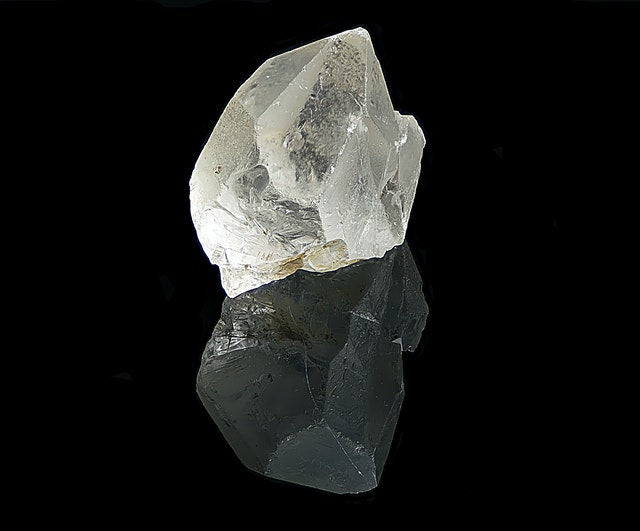ANOTHER property by means of which one may distinguish the various gems from each other
is hardness. By hardness is meant the ability to resist scratching. The term "hardness" should not
be taken to include toughness, yet it is frequently so understood by the public. Most hard stones
are more or less brittle and would shatter if struck a sharp blow. Other hard stones have a
pronounced cleavage and split easily in certain directions. True hardness, then, implies merely
the ability to resist abrasion (i. e., scratching).
Now, not only is hardness very necessary in a precious stone in order that it may receive and
keep a fine polish, but the degree in which it possesses hardness as compared[48] with other
materials of known hardness may be made use of in identifying it.
No scale of absolute hardness has ever come into general use, but the mineralogist Mohs many
years ago proposed the following relative scale, which has been used very largely:
Mohs's Scale of Hardness. Diamond, the hardest of all gems, was rated as 10 by Mohs. This
rating was purely arbitrary. Mohs might have called it 100 or 1 with equal reason. It was merely
in order to represent the different degrees of hardness by numbers, that he picked out the number
10 to assign to diamonds. Sapphire (and ruby) Mohs called 9, as being next to diamond in
hardness. True topaz (precious topaz) he called 8. Quartz (amethyst and quartz "topaz") was
given the number 7. Feldspar (moonstone) was rated 6, the mineral apatite 5, fluorspar 4, calcite
3, gypsum 2, and talc 1.
It may be said here that any mineral in this series, that is of higher number than[49] any other,
will scratch the other. Thus diamond (10) will scratch all the others, sapphire (9) will scratch any
but diamond, topaz (8) will scratch any but diamond and sapphire, and so on.
It must not be thought that there is any regularity in the degrees of hardness as expressed by
these numbers. The intervals in hardness are by no means equal to the differences in number.
Thus the interval between diamond and sapphire, although given but one number of difference,
is probably greater than that between sapphire (9) and talc (1). The numbers thus merely give us
an order of hardness. Many gem minerals are, of course, missing from this list, and most of the
minerals from 5 down to 1 are not gem minerals at all. Few gem materials are of less hardness
than 7, for any mineral less hard than quartz (7) will inevitably be worn and dulled in time by the
ordinary road dust, which contains much powdered quartz.[50]
In testing a gem for hardness the problem consists in finding out which of the above minerals is
most nearly equal in hardness to the unknown stone. Any gem that was approximately equal in
hardness to a true topaz (8) would also be said to be of hardness 8. Thus spinel is of about the
same hardness as topaz and hence is usually rated as 8 in hardness. Similarly opal, moonstone,
and turquoise are of about the same hardness as feldspar and are all rated 6.
Frequently stones will be found that in hardness are between some two of Mohs's minerals. In
that case we add one half to the number of the softer mineral; thus, peridot, benitoite, and jade
(nephrite) are all softer than quartz (7) but harder than feldspar (6); hence we say they are 61⁄2 in
hardness. Beryl (aquamarine and emerald), garnet (almandine), and zircon are rated 71⁄2 in
hardness, being softer than true topaz but harder than quartz. A table of the hardness of most
of[51] the commonly known gem-stones follows this lesson.
Having now an idea of what hardness means and how it is expressed, we must next inquire how
one may make use of it in identifying unknown gems.
How to Apply the Hardness Test. In the first place, it is necessary to caution the beginner
against damaging a fine gem by attempting to test its hardness in any but the most careful
manner. The time-honored file test is really a hardness test and serves nicely to distinguish
genuine gems, of hardness 7 or above, from glass imitations. A well-hardened steel file is of not
quite hardness 7, and glass of various types while varying somewhat averages between 5 and 6.
Hence, glass imitations are easily attacked by a file. To make the file test use only a very fine file
and apply it with a light but firm pressure lengthwise along the girdle (edge) of the unset stone.
If damage results it will then be almost unnoticeable.[52] Learn to know the feel of the file as it
takes hold of a substance softer than itself. Also learn the sound. If applied to a hard stone a file
will slip on it, as a skate slips on ice. It will not take hold as upon a softer substance.
If the stone is set, press a sharp corner of a broken-ended file gently against a back facet,
preferably high up toward the girdle, where any damage will not be visible from the front, and
move the file very slightly along the surface, noting by the feel whether or not it takes hold and
also looking with a lens to see if a scratch has been made. Do not mistake a line of steel, left on a
slightly rough surface, for a true scratch. Frequently on an unpolished girdle of real gem material
the file will leave a streak of steel. Similarly when using test minerals in accordance with what
follows do not mistake a streak of powder from the yielding test material, for a true scratch in the
material being tested. The safe way is to wipe the spot[53] thus removing any powder. A true
scratch will, of course, persist.
A doublet, being usually constructed of a garnet top and a glass back, may resist a file at the
girdle if the garnet top covers the stone to the girdle, as is sometimes the case, especially in the
smaller sizes. In this case the back must be tested.
One should never pass a file rudely across the corners or edges of the facets on any stone that
may be genuine, as such treatment really amounts to a series of light hammer blows, and the
brittleness of most gem stones would cause them to yield, irrespective of their hardness. It
should be remembered that some genuine stones are softer than a file, so that it will not do to
reject as worthless any material that is attacked by a file. Lapis lazuli (5), sphene (5), opal (6),
moonstone (6), amazonite (6), turquoise (6), peridot (61⁄2), demantoid garnet (61⁄2) (the "olivine"
of the trade), and jade[54] (nephrite) (61⁄2), are all more or less attacked by a file.

